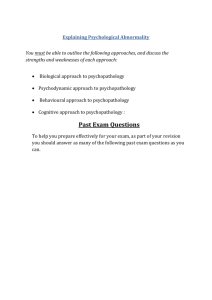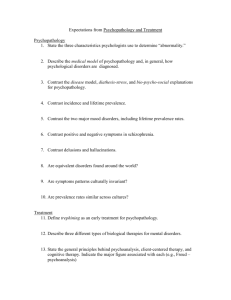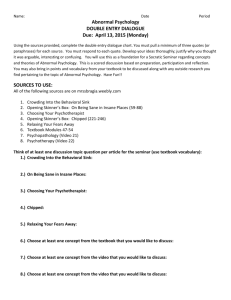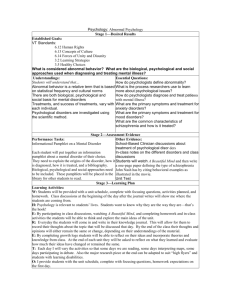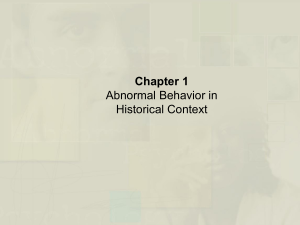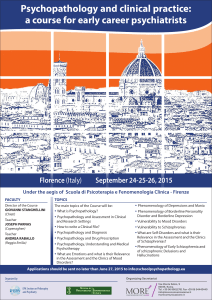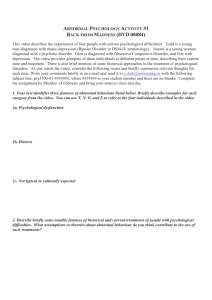Models of Psychopathology
advertisement
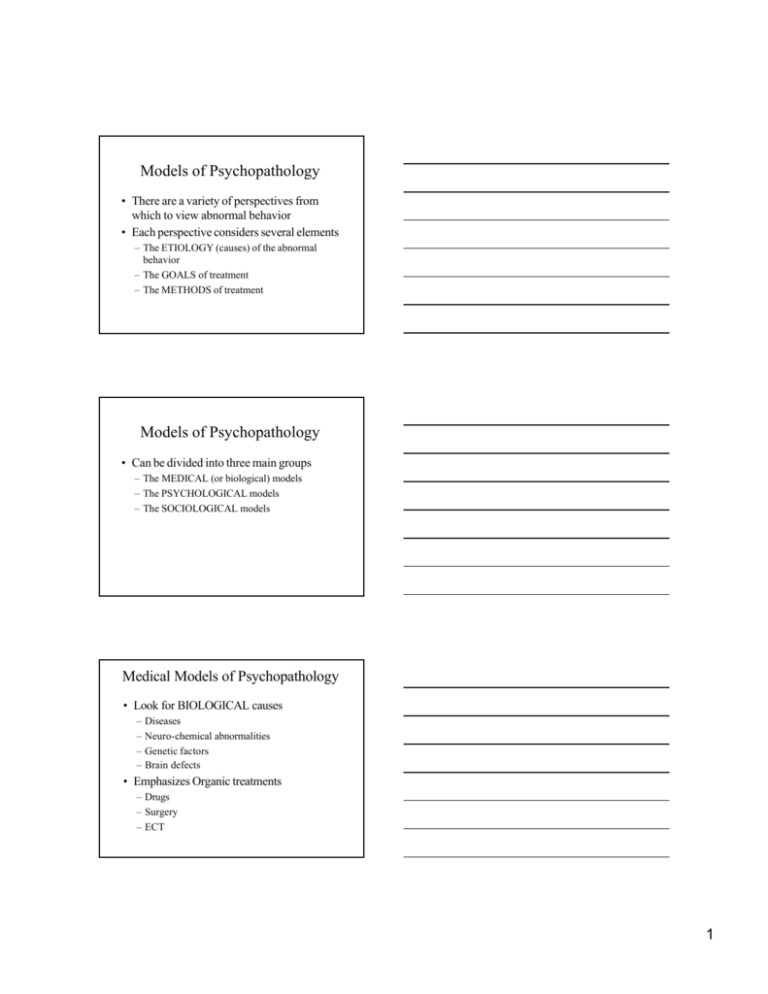
Models of Psychopathology • There are a variety of perspectives from which to view abnormal behavior • Each perspective considers several elements – The ETIOLOGY (causes) of the abnormal behavior – The GOALS of treatment – The METHODS of treatment Models of Psychopathology • Can be divided into three main groups – The MEDICAL (or biological) models – The PSYCHOLOGICAL models – The SOCIOLOGICAL models Medical Models of Psychopathology • Look for BIOLOGICAL causes – – – – Diseases Neuro-chemical abnormalities Genetic factors Brain defects • Emphasizes Organic treatments – Drugs – Surgery – ECT 1 Psychological Models of Psychopathology • Look for Psychological causes – – – – Early experiences Traumatic events Maladaptive learning experiences Illogical thinking • Emphasizes Psychological Treatment – Psychotherapy – Behavior therapy Sociocultural Models • Look for Social and Cultural Influences on Behavior – Societal norms and expectations – Sub-group influences – Family dynamics • Emphasizes Systems Approaches to Treatment – – – – Family Therapy Couples Therapy Group Therapy Community Interventions Biological Model of Abnormal Behavior • Assumes Faulty Biochemistry as Cause – Whole or in part – analogous to other medical problems • Assumes It Was Probably Present at Birth – Maybe the result of genetics 2 A Variant of This Model is the Diathesis-Stress Model • People are born with a somatic vulnerability • Interacts with stress from the environment • May or may not be evidenced depending on this interaction • Has been used to explain Schizophrenia and Bi-polar Diathesis-Stress Model • S T R E S S DIATHESIS LOW MED HIGH LOW NO NO ??? MED NO ??? YES HI NO YES YES Evidence for the Biological Model • Biological Markers – DST, CAT, PET • Response to Medication – Antidepressants, Antipsychotics • Relationship to Other Known Diseases/Treatments – Dopamine/Schizophrenia/Parkinsons 3 • Schiz + Thorazine ( Dopamine) = a in schizophrenic symptoms • Parkinson’s + L-Dopa (Dopamine) = schizophrenic symptoms in Kinship Studies • Does it Run in Families? • Does degree of kinship relate to likelihood of the disorder? – 1st degree relatives of a schizophrenic 4X more likely than general pop. to have the disorder – 1st degree relatives of someone with major depression 3X more likely • Does this control completely for environment? Twin Studies • Concordance rate for schizophrenia about 50% for MZ twins and 14% for DZ twins • For major depression its about 40% vs. 15% • For bi-polar disorder its 72% vs. 14% • Does this control completely for environment? 4 Adoption Studies – Hard to do, especially with MZ twins – Strong evidence for genetics in schiz. and bipolar Psychological Models of Psychopathology Psychoanalysis (Freud) • The First Formal Approach To Psychotherapy • Influenced Almost All Approaches Since • Influenced How Most People Think About Personality • Both A Personality Theory and An Approach To Treatment • Some of His Ideas Were Not New, But... 5 Psychoanalysis As A Personality Theory • Abnormal Behavior As Symptom • The Importance of Unconscious Conflicts • The Importance of Early Childhood Experiences • Stages of Psychosexual Development – Oral – Anal – Phallic Psychoanalysis as Psychotherapy • Importance of Making Unconscious Conflicts Conscious • Expose Early Childhood Roots of the Conflicts • Involves a Variety of Techniques – Free Association – Interpretation of Resistance – Interpretation of Tranference Behavior Therapy • Symptom As The Problem • Based on Learning (Conditioning) Principles • Many Fewer Assumptions Than Psychoanalysis • Treatment is Direct 6 Classical Conditioning (Pavlov) FOOD SALIVATION (US) (UR) BELL FOOD (NS) (US) SALIVATION (UR) BELL SALIVATION (CS) (CR) Classical Conditioning (Pavlov) FALLING FEAR (US) FLYING (NS) (UR) FALLING (US) FEAR (UR) Classical Conditioning (Pavlov) FALLING FEAR (US) FLYING (NS) (UR) FALLING (US) FEAR (UR) FLYING FEAR (CS) (CR) 7 Cognitive Therapy u Focuses on COGNITIONS (thinking) u Views abnormal behavior & feelings as a consequence of faulty thoughts to change behavior & feelings through changing beliefs u Attempts Rational-Emotive Therapy • Developed by Dr. Albert Ellis Usual View of The Relationship Between Events & Emotions/Behaviors A Activating Event (girlfriend leaves) C Consequences (depression) 8 Cognitive Therapy (RET) View of This Relationship A B Activating Event Belief System (girlfriend leaves) (e.g., “it’s awful!”) C Consequences (depression) Cognitive Therapy (RET) View of This Relationship A B Activating Event Belief System (girlfriend leaves) (e.g., “it’s bad!”) C Consequences (sadness) Irrational Beliefs (Ibs) • Demands we make: – On ourselves – On others – On the world • SHOULDs • MUSTs • OUGHT TOs 9 • I MUST be Thoroughly Accomplishing and Achieving at Everything I want to Accomplish and Achieve! • I MUST Be Liked, Loved or Admired by All Those I Want to Like, Love or Admire Me! Or else: • It PROVES I’m no good • It’s AWFUL • I CAN’T STAND it! Sociocultural Model of Psychopathology • Views Biological and Psychological Models as Incomplete • Views Abnormal Behavior as Significantly Influenced by Social and Cultural Forces • Argues That These Larger Group Forces Exert Important Influences – The stresses and supports to which individuals are exposed – If and how individuals behavior "abnormally" 10 Social and Cultural Forces • The Family of Origin – May have dynamics that can not be full understood at the individual level – Can be a source of stress or support – Can impact different members differently – Can "encourage" a member to be the "sick" one – Can discourage change in a member Social and Cultural Forces • The Family of Origin – May need to be seen interacting to be fully understood – This family "system" may need to be the target of intervention. • Not just the "symptomatic" family member – Can become the critically important source of positive change and support Social and Cultural Forces • Adult Couples – Can also have systemic features that may not be well understood at individual level – Are a system that can be a significant source of stress or support – May need to be treated as a system to maximize the impact of therapy on the individuals as well as on the relationship 11 Social and Cultural Forces • Sub-Cultures Can Impact Adjustment – Creating stress through holding values that may conflict with those of the larger society – By expecting & rewarding behaviors that outsiders might view as abnormal Social and Cultural Forces • Society Can Impact Adjustment – By the expectations it holds • money = happiness • young = good – By limiting opportunities for success for many – By pitting some groups against others – By limiting access to mental health resources – May Require Intervention at a Societal Level Social and Cultural Forces • Rates of Schizophrenia Go Down as Income Goes Up. Why? – Stresses associated with poverty – Poorer access to health and mental health care – Stresses associated with inner city life – Schizophrenics have difficulty keeping good jobs, so "drift down" the socioeconomic ladder 12
